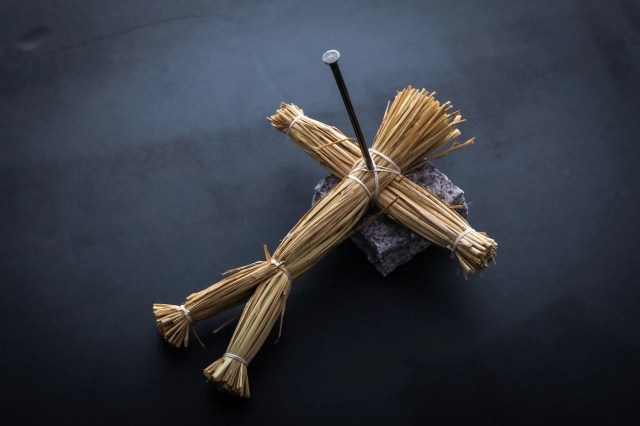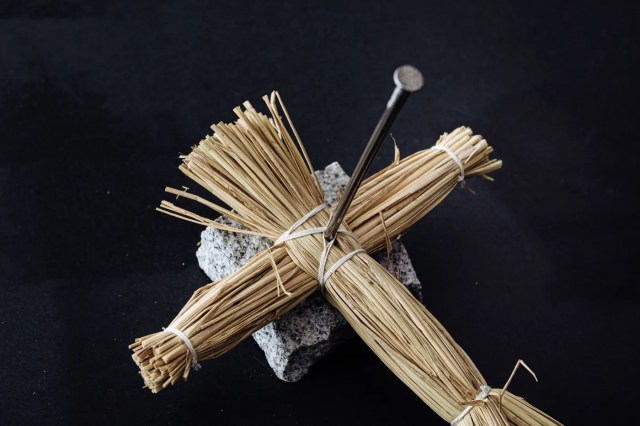
”Praying for his death” reads wara ningyo note.
Summer is the traditional season for scary stories in Japan, and right on cue, we’ve got a spooky tale coming out of Chiba Prefecture. It’s also a pretty bizarre situation, but we’ll start with the creepy aspects.
In Japan, there’s a kind of doll called a wara ningyo. That translates to “straw doll,” but wara ningyo are no innocuous arts and crafts projects. Instead, they’re Japan’s version of voodoo dolls, created as an effigy for someone you wish harm to befall. Instead of damaging the wara ningyo directly, though, you’re supposed to nail it to a tree inside the boundaries of a Shinto shrine between the hours of 1 and 3 a.m., in a ceremony called ushi no toki mairi, or “shrine visit during the hour of the ox” (in the old Japanese time-keeping system, the hour of the ox was designated to what we now call 1 to 3 in the morning).
▼ A wara ningyo
The standard curse inflicted by wara ningyo is supposed to be death, but these days most people with murderous intent tend to opt for more direct means. Because of that, the dolls are now pretty rare outside of horror movies and anime, but since the start of last month, wara ningyo have been found nailed to trees on the grounds of seven shrines in the town of Matsudo, about 20 minutes east of downtown Tokyo. In a modern twist, each one of them also has a photograph of the same person’s face attached to the head.
So just who is the intended target of this dark magic? None other than…
… Russian president Vladimir Putin. Oh, and just in case whatever spirits are supposed to carry out the curse don’t recognize the Russian head of state by sight, at least one of the dolls, the one found at Masudo’s Kanegasaku Kuamano Shrine, also had a piece of paper folded up inside of it with Putin’s full name, current age, and date of birth, all written in Japanese, as well as the message “Praying for his death.”
Even prior to the ongoing Russian invasion of Ukraine, Putin wasn’t the most popular politician internationally, and the ongoing conflict hasn’t done anything to improve his image in Japan. That said, it’s pretty shocking to see such old-school methods employed in protest, as Japanese Twitter reactions show:
“I was actually at one of the shrines where this happened and saw the wara ningyo nailed to the tree. Couldn’t believe my eyes.”
“Having a hard time imagining Putin dropping dead because some Japanese person put a curse on him.”
“Do wara ningyo curses have the kind of range to hit people overseas?”
“Those are some really beautifully made wara ningyo.”
“Hammering a nail into a shrine’s sacred tree? That’s gonna get whoever did it some divine retribution raining down on them.”
As alluded to in the last comment, in the Shinto religion nature is held to be divine, and a shrine’s trees in particular are often considered sacred. At Kanegasaku Kuamano Shrine, for example, the doll was found nailed to its camphor tree, which is more than 200 years old and predates even the shrine itself. Priests and shrine caretakers are asking that whoever is carrying out the ushi no toki mairi cease and desist, and while the curse itself is not a chargeable offense, local police are investigating the incidents as crimes of trespassing and vandalism.
Source: Asahi Shimbun Digital via Livedoor News via Jin, Chiba TV, FNN Prime Online, Twitter (1, 2)
Top image: Pakutaso
Insert images: Pakutaso
● Want to hear about SoraNews24’s latest articles as soon as they’re published? Follow us on Facebook and Twitter!
Follow Casey on Twitter, where, as with so many other things, he first learned about wara ningyo from Ranma 1/2.


 Charges dropped against elderly Japanese man for nailing Putin voodoo doll to sacred shrine tree
Charges dropped against elderly Japanese man for nailing Putin voodoo doll to sacred shrine tree Hatsune Miku becomes classic hina doll to show girls they don’t have to get married to be happy
Hatsune Miku becomes classic hina doll to show girls they don’t have to get married to be happy Mermaid mummy stored at Japanese temple has true identity revealed after year-long study【Video】
Mermaid mummy stored at Japanese temple has true identity revealed after year-long study【Video】 Starbucks Reserve Roastery sells lucky Japanese figurines to ring in 2023
Starbucks Reserve Roastery sells lucky Japanese figurines to ring in 2023 Batman as a samurai ningyo figure is trans-Pacific time-tripping awesomeness
Batman as a samurai ningyo figure is trans-Pacific time-tripping awesomeness McDonald’s new Happy Meals offer up cute and practical Sanrio lifestyle goods
McDonald’s new Happy Meals offer up cute and practical Sanrio lifestyle goods All-you-can-drink Starbucks and amazing views part of Tokyo’s new 170 meter-high sky lounge
All-you-can-drink Starbucks and amazing views part of Tokyo’s new 170 meter-high sky lounge Super Nintendo World expansion gets delayed for several months at Universal Studios Japan
Super Nintendo World expansion gets delayed for several months at Universal Studios Japan Beautiful Sailor Moon manhole cover coasters being given out for free by Tokyo tourist center
Beautiful Sailor Moon manhole cover coasters being given out for free by Tokyo tourist center Kyoto’s 100 Demons yokai monster parade returns!
Kyoto’s 100 Demons yokai monster parade returns! Studio Ghibli glasses cases let anime characters keep an eye on your spectacles
Studio Ghibli glasses cases let anime characters keep an eye on your spectacles Starbucks reopens at Shibuya Scramble Crossing with new look and design concept
Starbucks reopens at Shibuya Scramble Crossing with new look and design concept More foreign tourists than ever before in history visited Japan last month
More foreign tourists than ever before in history visited Japan last month The oldest tunnel in Japan is believed to be haunted, and strange things happen when we go there
The oldest tunnel in Japan is believed to be haunted, and strange things happen when we go there Ghibli background artist Naohisa Inoue’s painting technique is out of this world
Ghibli background artist Naohisa Inoue’s painting technique is out of this world Disney princesses get official manga makeovers for Manga Princess Cafe opening in Tokyo
Disney princesses get official manga makeovers for Manga Princess Cafe opening in Tokyo Beautiful new Final Fantasy T-shirt collection on the way from Uniqlo【Photos】
Beautiful new Final Fantasy T-shirt collection on the way from Uniqlo【Photos】 Is the new Shinkansen Train Desk ticket worth it?
Is the new Shinkansen Train Desk ticket worth it? Foreign English teachers in Japan pick their favorite Japanese-language phrases【Survey】
Foreign English teachers in Japan pick their favorite Japanese-language phrases【Survey】 Japanese convenience store packs a whole bento into an onigiri rice ball
Japanese convenience store packs a whole bento into an onigiri rice ball We try out “Chan Ramen”, an underground type of ramen popular in the ramen community
We try out “Chan Ramen”, an underground type of ramen popular in the ramen community Studio Ghibli releases Kiki’s Delivery Service chocolate cake pouches in Japan
Studio Ghibli releases Kiki’s Delivery Service chocolate cake pouches in Japan Japan’s bone-breaking and record-breaking roller coaster is permanently shutting down
Japan’s bone-breaking and record-breaking roller coaster is permanently shutting down New definition of “Japanese whiskey” goes into effect to prevent fakes from fooling overseas buyers
New definition of “Japanese whiskey” goes into effect to prevent fakes from fooling overseas buyers Our Japanese reporter visits Costco in the U.S., finds super American and very Japanese things
Our Japanese reporter visits Costco in the U.S., finds super American and very Japanese things Studio Ghibli unveils Mother’s Day gift set that captures the love in My Neighbour Totoro
Studio Ghibli unveils Mother’s Day gift set that captures the love in My Neighbour Totoro Foreign passenger shoves conductor on one of the last full runs for Japan’s Thunderbird train
Foreign passenger shoves conductor on one of the last full runs for Japan’s Thunderbird train Domino’s Japan now sells…pizza ears?
Domino’s Japan now sells…pizza ears? New Japanese KitKat flavour stars Sanrio characters, including Hello Kitty
New Japanese KitKat flavour stars Sanrio characters, including Hello Kitty Kyoto creates new for-tourist buses to address overtourism with higher prices, faster rides
Kyoto creates new for-tourist buses to address overtourism with higher prices, faster rides Sales of Japan’s most convenient train ticket/shopping payment cards suspended indefinitely
Sales of Japan’s most convenient train ticket/shopping payment cards suspended indefinitely Sold-out Studio Ghibli desktop humidifiers are back so Totoro can help you through the dry season
Sold-out Studio Ghibli desktop humidifiers are back so Totoro can help you through the dry season Japanese government to make first change to romanization spelling rules since the 1950s
Japanese government to make first change to romanization spelling rules since the 1950s Ghibli founders Toshio Suzuki and Hayao Miyazaki contribute to Japanese whisky Totoro label design
Ghibli founders Toshio Suzuki and Hayao Miyazaki contribute to Japanese whisky Totoro label design Doraemon found buried at sea as scene from 1993 anime becomes real life【Photos】
Doraemon found buried at sea as scene from 1993 anime becomes real life【Photos】 Tokyo’s most famous Starbucks is closed
Tokyo’s most famous Starbucks is closed One Piece characters’ nationalities revealed, but fans have mixed opinions
One Piece characters’ nationalities revealed, but fans have mixed opinions We asked a Uniqlo employee what four things we should buy and their suggestions didn’t disappoint
We asked a Uniqlo employee what four things we should buy and their suggestions didn’t disappoint Princesses, fruits, and blacksmiths: Study reveals the 30 most unusual family names in Japan
Princesses, fruits, and blacksmiths: Study reveals the 30 most unusual family names in Japan Sacred 1,200-year-old tree toppled by severe storm at shrine in central Japan【Photos】
Sacred 1,200-year-old tree toppled by severe storm at shrine in central Japan【Photos】 Hayao Miyazaki sketches cute characters for new signboard at the Ghibli Museum【Video】
Hayao Miyazaki sketches cute characters for new signboard at the Ghibli Museum【Video】 Japanese survey finds top 10 emoji that “make you look like an old man”
Japanese survey finds top 10 emoji that “make you look like an old man” At this Kyoto shrine, be careful what you wish for—and how—, because you just might get it
At this Kyoto shrine, be careful what you wish for—and how—, because you just might get it Yaoi fans rejoice as Shinto shrine seems to open part-time positions for male shrine maidens
Yaoi fans rejoice as Shinto shrine seems to open part-time positions for male shrine maidens Gigantic geyser erupts from Shinto shrine’s forest on the night before its summer festival【Video】
Gigantic geyser erupts from Shinto shrine’s forest on the night before its summer festival【Video】 The only path to this Nagasaki Shinto shrine gets swallowed by the sea every day【Video】
The only path to this Nagasaki Shinto shrine gets swallowed by the sea every day【Video】 TripAdvisor Japan announces the country’s 10 favorite shrines and temples
TripAdvisor Japan announces the country’s 10 favorite shrines and temples Feel what it’s like to be a Shinto shrine maiden with shrine’s experience package for foreigners
Feel what it’s like to be a Shinto shrine maiden with shrine’s experience package for foreigners Japanese shrine creates special water fountain for thirsty bees
Japanese shrine creates special water fountain for thirsty bees Visiting a maximum security shrine at the foot of the Narita airport runway
Visiting a maximum security shrine at the foot of the Narita airport runway Electronic grandchild “Ami-chan” developed by Takara Tomy
Electronic grandchild “Ami-chan” developed by Takara Tomy Akihabara’s otaku shrine celebrates PlayStation 5 launch with ethereal one-night event
Akihabara’s otaku shrine celebrates PlayStation 5 launch with ethereal one-night event Ladies and Gentlemen, the comedy stylings of Vladimir Putin 【Video】
Ladies and Gentlemen, the comedy stylings of Vladimir Putin 【Video】 Studio Ghibli releases new free-to-use anime images to “use within the bounds of common sense”
Studio Ghibli releases new free-to-use anime images to “use within the bounds of common sense”
Leave a Reply